A) average cost of the product development equals the average revenue generated.
B) new product actually brings great benefits to the consumer.
C) producer's marginal cost of product development equals the consumer's marginal benefit.
D) producer surplus from selling the product equals the consumer surplus.
Correct Answer

verified
Correct Answer
verified
Multiple Choice
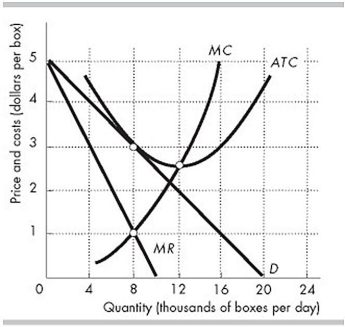 -Fresh Taste, Inc. produces organic breakfast cereals. The market for breakfast cereals is monopolistically competitive. The figure above shows the demand curve that Fresh Taste faces (D) , the company's marginal revenue curve (MR) , its marginal cost curve (MC) , and its average total cost curve (ATC) .
Fresh Taste produces _______ thousand boxes of cereal per day and sets a price of _______ a box.
-Fresh Taste, Inc. produces organic breakfast cereals. The market for breakfast cereals is monopolistically competitive. The figure above shows the demand curve that Fresh Taste faces (D) , the company's marginal revenue curve (MR) , its marginal cost curve (MC) , and its average total cost curve (ATC) .
Fresh Taste produces _______ thousand boxes of cereal per day and sets a price of _______ a box.
A) 8; $1.00
B) 8; $3.00
C) 12; between $3.00 and $2.01
D) 12; $2.00
Correct Answer

verified
Correct Answer
verified
Multiple Choice
A monopolistically competitive firm is making a positive economic profit. In the long run, which of the following is most likely?
A) It will produce less output but keep price the same.
B) It will keep output the same but will charge a higher price.
C) It will produce less output and it will charge a lower price.
D) It will produce the same output and charge the same price.
Correct Answer

verified
Correct Answer
verified
Multiple Choice
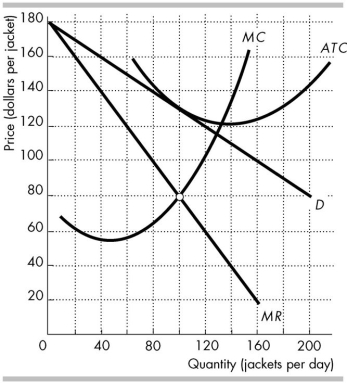 -In the figure above, what is Gap's markup?
-In the figure above, what is Gap's markup?
A) $15
B) $35
C) Zero
D) $50
Correct Answer

verified
Correct Answer
verified
Multiple Choice
A positive markup is earned by a firm if
A) its price exceeds its marginal cost.
B) price equals marginal cost.
C) marginal revenue equals marginal cost.
D) price equals average total cost.
Correct Answer

verified
Correct Answer
verified
Multiple Choice
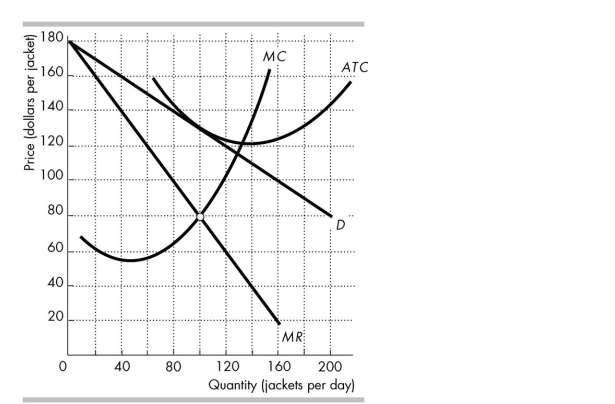 -In the figure above, Gap maximises its profit if it sells _______ jackets per day.
-In the figure above, Gap maximises its profit if it sells _______ jackets per day.
A) 133
B) 64
C) 129
D) 100
Correct Answer

verified
Correct Answer
verified
Multiple Choice
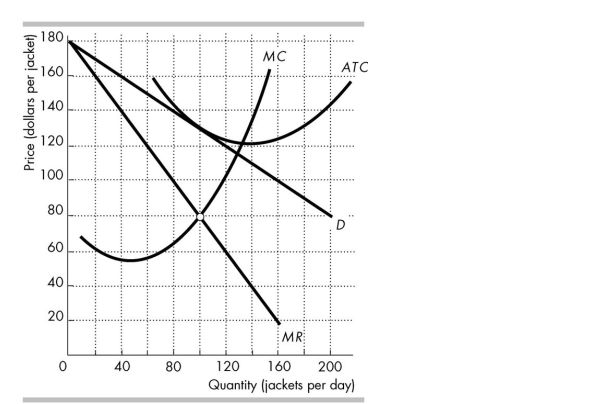 -In the figure above, what is Gap's excess capacity?
-In the figure above, what is Gap's excess capacity?
A) 4 jackets per day
B) 132 jackets per day
C) Zero
D) 32 jackets per day
Correct Answer

verified
Correct Answer
verified
Multiple Choice
In monopolistic competition, profit is maximised when the amount produced is such that
A) marginal revenue is greater than marginal cost.
B) total revenue is maximised.
C) total revenue equals total cost.
D) marginal revenue equals marginal cost.
Correct Answer

verified
Correct Answer
verified
Multiple Choice
If a firm spends $600 on advertising, its
A) ATC curve shifts upward and its MC curve shifts downward.
B) ATC curve shifts upward and its MC curve does not shift.
C) ATC and MC curves shift upward.
D) MC curve shifts upward and its ATC curve does not shift.
Correct Answer

verified
Correct Answer
verified
Multiple Choice
A monopolistically competitive firm is similar to
A) a perfectly competitive firm in the short run because it cannot make an economic profit in the short run and is similar to a monopoly in the long run because it can make an economic profit.
B) a perfectly competitive firm because its economic profit is equal to zero in both the short run and long run.
C) a monopoly because it can make an economic profit in both the short run and long run.
D) a monopoly in the short run because it can make an economic profit in the short run and is similar to a perfectly competitive firm in the long run because it cannot make a positive economic profit.
Correct Answer

verified
Correct Answer
verified
Multiple Choice
Selling costs, such as advertising, are likely to be a large share of total cost in an industry that is
A) a monopoly.
B) non- profit.
C) monopolistically competitive.
D) perfectly competitive.
Correct Answer

verified
Correct Answer
verified
Multiple Choice
 -In the above figure of a monopolistically competitive firm, the area of economic profit is
-In the above figure of a monopolistically competitive firm, the area of economic profit is
A) P2AD P4.
B) ADB.
C) P2FEP5.
D) ABC.
Correct Answer

verified
Correct Answer
verified
Multiple Choice
Monopolistic competition is a market structure in which
A) each firm produces an identical product.
B) firms only compete on product price.
C) firms are free to enter or exit.
D) a small number of firms compete.
Correct Answer

verified
Correct Answer
verified
Multiple Choice
How is a monopolistically competitive firm similar to a perfectly competitive firm?
A) Both will observe entry into the industry if economic profit is positive.
B) Both produce a homogeneous good.
C) Both produce where average total cost equals marginal cost.
D) Both make a positive economic profit in the long run.
Correct Answer

verified
Correct Answer
verified
Multiple Choice
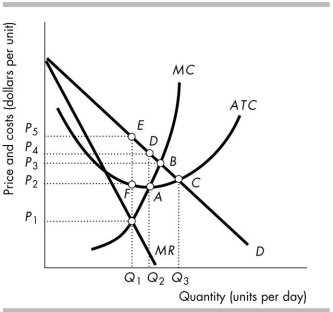 -The above figure shows a monopolistically competitive firm. The figure
-The above figure shows a monopolistically competitive firm. The figure
A) could be either a short- run or long- run illustration because monopolistically competitive firms can make an economic profit in the long- run.
B) is only a long- run illustration because the firm is making zero economic profit.
C) is only a short- run illustration because the firm is making an economic profit.
D) is neither a short- nor a long- run illustration.
Correct Answer

verified
Correct Answer
verified
Multiple Choice
Product differentiation is a defining characteristic of
A) perfect competition.
B) perfectly elastic demand.
C) oligopoly.
D) monopolistic competition.
Correct Answer

verified
Correct Answer
verified
Multiple Choice
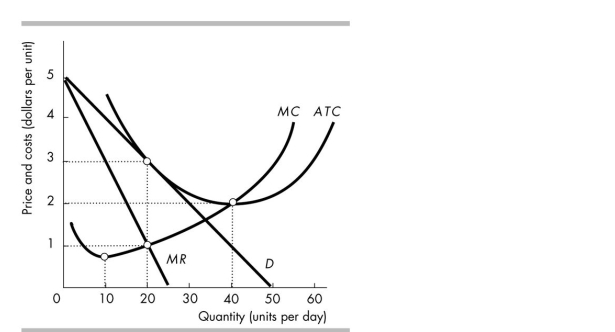 -The firm in the figure above is in monopolistic competition. It will set a price equal to
-The firm in the figure above is in monopolistic competition. It will set a price equal to
A) $1.
B) $2.
C) $3.
D) more than $3.
Correct Answer

verified
Correct Answer
verified
Multiple Choice
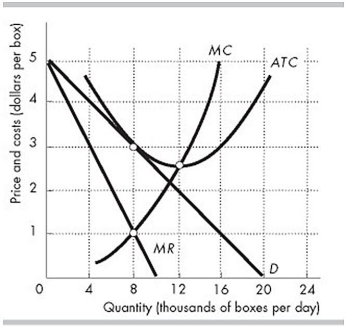 -Fresh Taste, Inc. produces organic breakfast cereals. The market for breakfast cereals is monopolistically competitive. The figure above shows the demand curve that Fresh Taste faces (D) , the company's marginal revenue curve (MR) , its marginal cost curve (MC) , and its average total cost curve (ATC) . Fresh Taste's economic profit is
-Fresh Taste, Inc. produces organic breakfast cereals. The market for breakfast cereals is monopolistically competitive. The figure above shows the demand curve that Fresh Taste faces (D) , the company's marginal revenue curve (MR) , its marginal cost curve (MC) , and its average total cost curve (ATC) . Fresh Taste's economic profit is
A) zero, that is, it earns only a normal profit.
B) $8,000 per day.
C) $16,000 per day.
D) None of the above answers is correct.
Correct Answer

verified
Correct Answer
verified
Multiple Choice
In monopolistic competition, product improvement and development
A) are valued by the consumer at an amount equal to the costs the producers have incurred.
B) is less than its efficient amount.
C) yields a marginal benefit to the producer equal to the price of the good.
D) None of the above answers is correct.
Correct Answer

verified
Correct Answer
verified
Multiple Choice
In monopolistic competition, in the long run firms have
A) a capacity shortage.
B) an economic loss.
C) excess capacity.
D) an economic profit.
Correct Answer

verified
Correct Answer
verified
Showing 61 - 80 of 150
Related Exams